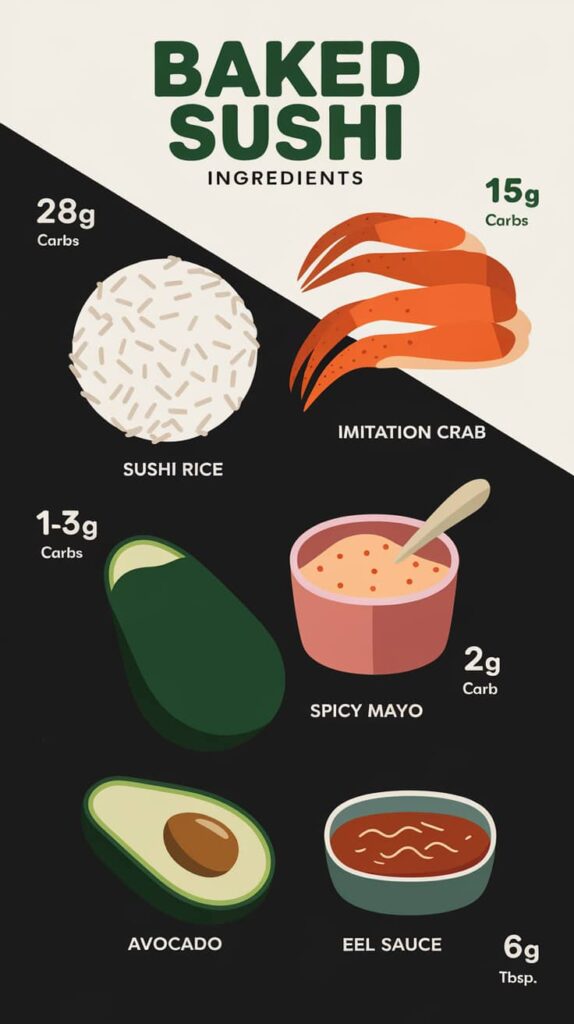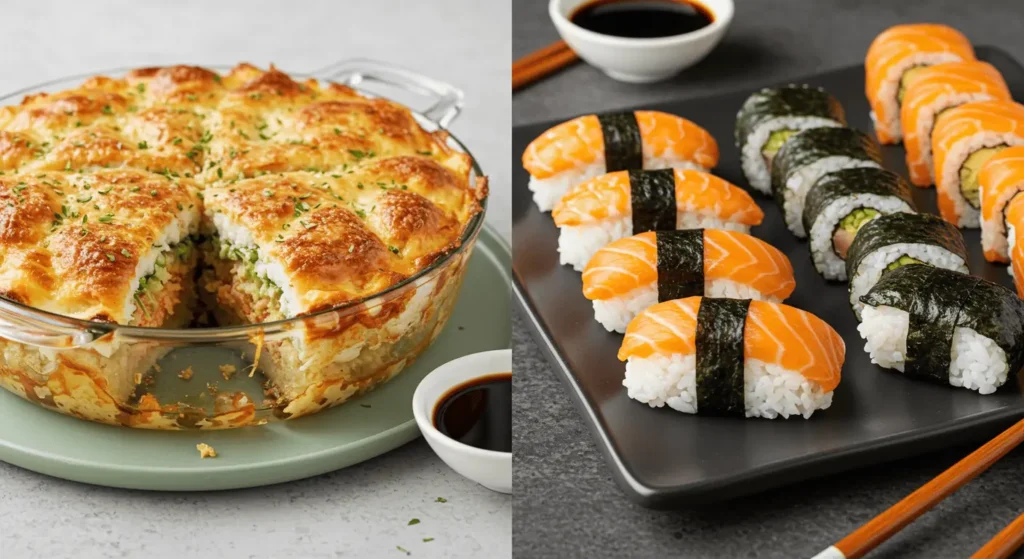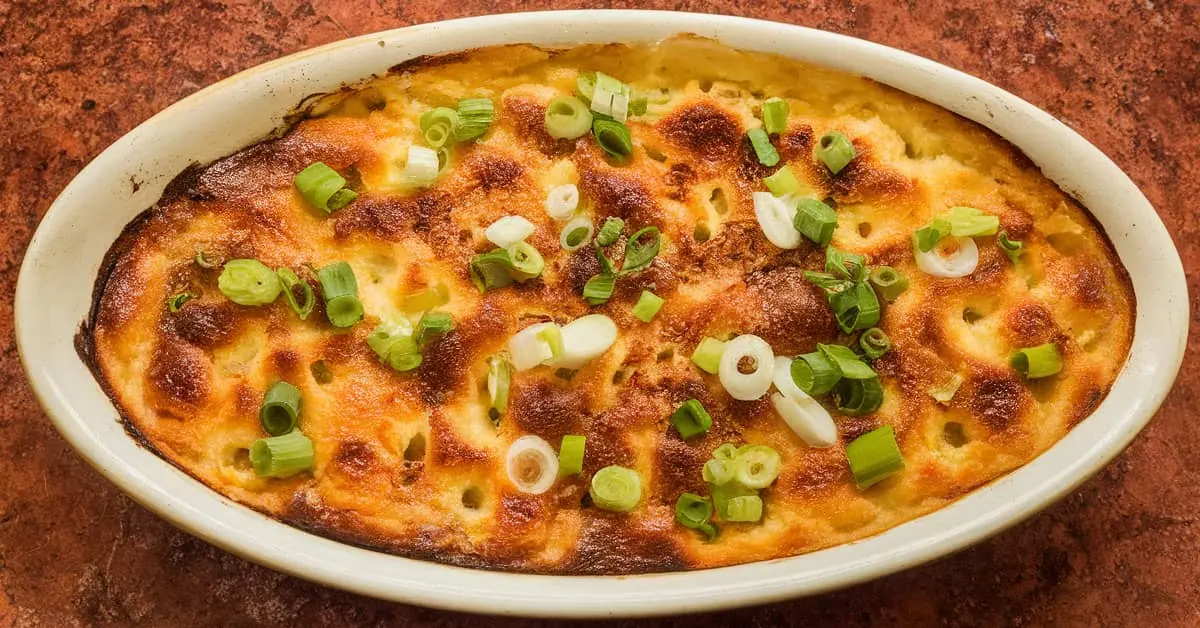Baked sushi has become a popular twist on traditional sushi, offering a warm, creamy, and flavorful experience. But if you’re mindful of your carbohydrate intake—whether for weight management, diabetes control, or following a low-carb diet—you might wonder: How many carbs are in baked sushi?
In this comprehensive guide, we’ll break down the carb content of baked sushi, compare it with other sushi varieties, and share tips for enjoying sushi without overloading on carbs.

What Is Baked Sushi?
Baked sushi is a casserole-style version of traditional sushi, featuring layers of seasoned rice, seafood, creamy sauces, and crunchy toppings. Unlike regular sushi rolls, it’s served warm and eaten with seaweed sheets for wrapping individual bites.
If you’re curious about sushi’s basic components, check out what are the three main ingredients in sushi. Understanding these core ingredients can help you identify where most of the carbs come from.
The Role of Carbohydrates in Sushi
Carbs in sushi come from more than just rice. Here’s where they hide:
- Sushi Rice: The biggest carb source, often seasoned with sugar and vinegar.
- Fillings: Ingredients like imitation crab, avocado, and cream cheese add extra carbs.
- Toppings and Sauces: Spicy mayo and eel sauce can be sneaky sources of sugar.
If you’re making baked sushi at home, consider trying this easy delicious sushi bake recipe to control ingredients and carb content.
How Many Carbs Are in Baked Sushi? (Carb Breakdown)
Understanding where the carbs come from helps you manage your intake effectively. Here’s a breakdown:
1. Sushi Rice (The Major Carb Source)
- 1 cup of cooked sushi rice = 28-30 grams of carbs
- Made with vinegar and sugar, increasing carb count
2. Fillings & Toppings
- Imitation Crab (surimi): 13-15g carbs per 100g due to added starches
- Avocado: 2g net carbs per 50g (healthy fats balance it out)
- Cream Cheese: Minimal carbs (1-2g per serving)
- Seafood (shrimp, salmon, etc.): Virtually zero carbs
3. Sauces
- Spicy Mayo: 1-2g carbs per tablespoon
- Eel Sauce: 6-8g carbs per tablespoon (high sugar content)
Factors That Affect How Many Carbs Are in Baked Sushi
When calculating carbs in baked sushi, consider these factors:
- Portion Size: Larger servings = more carbs
- Type of Rice: White rice has more carbs than brown or cauliflower rice
- Added Sugars: Some sauces and marinades sneak in extra carbs
- Toppings: Creamy sauces, fried toppings, and sweet glazes increase carbs
How to Calculate How Many Carbs Are in Homemade Baked Sushi
Want to make baked sushi at home? Here’s how to calculate carbs accurately:
- List All Ingredients: Note the weight/serving size of each.
- Check Nutrition Labels: Especially for sauces, crab sticks, and rice.
- Use Carb-Counting Apps: Tools like MyFitnessPal or Carb Manager simplify tracking.
If you’re new to carb counting, the CDC’s carb-counting guide is a great resource.
Low-Carb Alternatives: How to Reduce Carbs in Baked Sushi
Craving sushi but watching your carbs? Try these low-carb swaps:
- Cauliflower Rice: Just 4g net carbs per cup—a fraction of sushi rice’s carb count.
- Quinoa: Lower in carbs than white rice, with added protein.
- Nori Wraps: Skip the rice and enjoy baked sushi as seaweed wraps.
Baked Sushi vs. Other Sushi Types: Carb Comparison
| Sushi Type | Carbs (per serving) |
|---|---|
| Baked Sushi (1 cup) | 30-40g |
| California Roll (1 roll) | 28-38g |
| Spicy Tuna Roll (1 roll) | 32-40g |
| Sashimi (5 pieces) | 0-2g |
| Nigiri (2 pieces) | 15-20g |
Key Takeaways:
- Baked sushi is higher in carbs due to creamy sauces and rice layers.
- Sashimi is the lowest-carb option—no rice, no sauces, just pure protein.

Should You Eat Baked Sushi Hot or Cold?
Interestingly, some people prefer eating baked sushi cold, while others enjoy it warm right out of the oven. If you’re curious about which method brings out the best flavors, read should you eat sushi bake hot or cold.
Health Implications of High-Carb Sushi
While sushi can be part of a balanced diet, high-carb versions may:
- Spike blood sugar levels, especially in individuals with diabetes.
- Cause energy crashes due to rapid digestion of refined carbs.
- Hinder weight loss efforts if consumed in large portions.
Tip: Pair sushi with a fiber-rich salad or protein to stabilize blood sugar.
Frequently Asked Questions (FAQ)
1. Is baked sushi high in carbs?
Yes, baked sushi is relatively high in carbs due to sushi rice, creamy sauces, and sweet toppings. A typical serving can contain 30-40g of carbs.
2. How many carbs are in a California-baked sushi roll?
A baked California roll has about 28-38g of carbs per roll, depending on ingredients like crab sticks and sauces.
3. Can I eat baked sushi on a low-carb diet?
You can enjoy baked sushi on a low-carb diet by using cauliflower rice, limiting sugary sauces, and increasing protein-based toppings.
4. What type of sushi has the least carbs?
Sashimi is the lowest-carb sushi option since it’s just raw fish without rice. Cucumber-wrapped rolls are also low in carbs.
5. Does sushi rice have more carbs than regular rice?
Yes, sushi rice often has more carbs because it’s seasoned with sugar and vinegar, increasing its glycemic index.
Final Thoughts
While baked sushi is delicious, it’s important to be mindful of its carbohydrate content—especially if you’re managing your blood sugar, on a low-carb diet, or counting calories. By understanding the ingredients, portion sizes, and carb swaps available, you can enjoy this tasty dish without derailing your health goals.
Want to try making your own? Check out this easy sushi bake recipe to get started!
